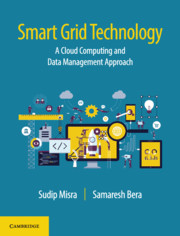Book contents
- Frontmatter
- dedication
- Contents
- Figures
- Tables
- Foreword
- Preface
- Part I Introduction
- Part II Cloud Computing Applications for Smart Grid
- 5 Demand Response
- 6 Geographical Load-Balancing
- 7 Dynamic Pricing
- 8 Virtual Power Plant
- 9 Advanced Metering Infrastructure
- 10 Cloud-Based Security and Privacy
- Part III Smart Grid Data Management and Applications
- Part IV Smart Grid Design and Deployment
- Index
9 - Advanced Metering Infrastructure
from Part II - Cloud Computing Applications for Smart Grid
Published online by Cambridge University Press: 20 October 2018
- Frontmatter
- dedication
- Contents
- Figures
- Tables
- Foreword
- Preface
- Part I Introduction
- Part II Cloud Computing Applications for Smart Grid
- 5 Demand Response
- 6 Geographical Load-Balancing
- 7 Dynamic Pricing
- 8 Virtual Power Plant
- 9 Advanced Metering Infrastructure
- 10 Cloud-Based Security and Privacy
- Part III Smart Grid Data Management and Applications
- Part IV Smart Grid Design and Deployment
- Index
Summary
Advanced metering infrastructure (AMI) is an important component of a smart grid that can help in fulfilling the objectives of the latter. It is a combination of smart meters and bi-directional communication networks. With the help of AMI, customers, service providers, and other entities exchange information among themselves in order to have a well-balanced smart grid environment. Consequently, with the wide deployment of smart meters supported by bi-directional communication networks, it is easier to monitor real-time energy supply–demand information, automatic billing, and many others. Moreover, it is one of the primary requirements for establishing a smart grid environment.
Requirements
Typically, an AMI system should meet the following requirements [1]:
• Data storage: Energy consumption data is required to be stored in the smart meter. Therefore, the AMI should help smart meters to store real-time and past energy consumption data. To fulfill this requirement, adequate memory should be installed in the smart meters. Moreover, it is also required to ensure that the stored data is accessible by only authenticated users.
• Communication: Different communication protocols are also required to communicate with different entities; examples include the IEEE 802.15.4, IEEE 802.11, and wide area network protocols. For example, home appliances may communicate with the home energy management unit (HEMU) using the IEEE 802.15.4 protocol. On the other hand, a HEMU may communicate with the local aggregator unit using the IEEE 802.11 protocol. Finally, the aggregator units may communicate with the service provider through the protocols used in wide area networks. Therefore, suitable communication protocols are required to be deployed, taking into consideration both their advantages and disadvantages.
• Management: Different management functions include remote management, billing management, and load control. All these tasks should be performed in an adaptive manner without the involvement of human beings. In case of remote management, fault in the smart meter must be rectified, and the corresponding action should be taken in order to avoid service disruption. In case of billing management, customers can be automatically billed according to their energy consumption. Finally, in case of load control, energy demand from some of the smart meters can be discarded to establish a balance between the energy supply and demand.
• User interface: It can be used as an alternative to users for accessing AMI information; the interface includes LCD displays, graphics constructions, keyboard, and a website with authorization facility.
- Type
- Chapter
- Information
- Smart Grid TechnologyA Cloud Computing and Data Management Approach, pp. 118 - 146Publisher: Cambridge University PressPrint publication year: 2018
- 2
- Cited by

